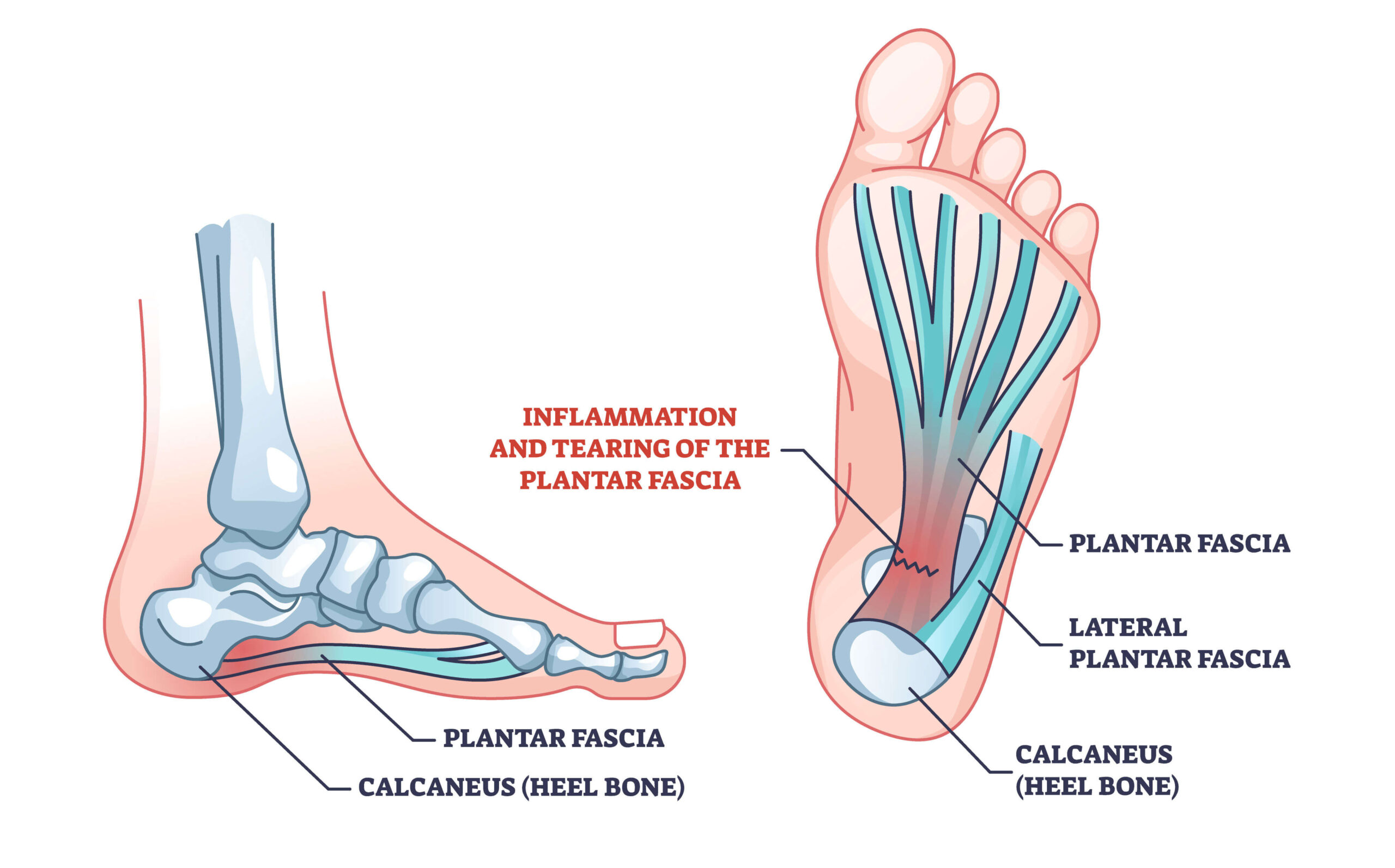Plantar Fascia Tears: Symptoms, Causes & Treatment
Plantar fascia tears are a common cause of heel pain and can be a frustrating injury for those who experience them. The plantar fascia is a band of tissue that runs along the bottom of your foot, from your heel to the base of your toes. It supports the arch of the foot and helps you push off when you walk. When this tissue becomes inflamed or tears, it can cause pain and difficulty walking.
What is a Plantar Fascia Tear?
A plantar fascia tear is a rupture or separation of the plantar fascia from the heel bone. It can be a complete or partial tear and occur anywhere along the length of the fascia.
The plantar fascia is located on the bottom of the foot, near the heel. It runs from the heel bone to the base of the toes and helps support the arch of the foot.
Symptoms of a Plantar Fascia Tear
- Pain in the Foot: The most common symptom of a plantar fascia tear is a pain in the foot, specifically in the heel and arch. The pain may be constant or may only occur when standing or walking.
- Swelling: Swelling may also occur in the affected area of the foot.
- Difficulty Walking: The pain and swelling associated with a plantar fascia tear may make it difficult to walk or bear weight on the affected foot.

Causes of a Plantar Fascia Tear
Overuse Injuries
One of the most common causes of plantar fascia tears is overuse injuries. This tear can occur in individuals who engage in activities that put a lot of strain on the foot, such as running or dancing. It can also occur in people who have occupations that require standing or walking for long periods.
Acute Trauma
A plantar fascia tear can also be caused by acute trauma, such as falling or awkwardly landing on the foot.
Weak Foot Muscles
Weak foot muscles can contribute to the development of a plantar fascia tear. When the muscles in the foot are weak, they cannot provide adequate support to the plantar fascia, which can lead to injury.
Diagnosis of a Plantar Fascia Tear
A podiatrist or other healthcare professional can diagnose a plantar fascia tear. The healthcare professional will start by taking a medical history and performing a physical exam of the foot.
Physical Exam
During the physical exam, the healthcare professional will look for signs of a plantar fascia tear, such as swelling, tenderness, and bruising. They may also ask the individual to walk or bear weight on the affected foot to assess the extent of the injury.
Imaging Tests
In some cases, imaging tests may be ordered to confirm the diagnosis and determine the extent of the tear. These tests may include x-rays, MRI, or CT scans.

Treatment of a Plantar Fascia Tear
The treatment of a plantar fascia tear will depend on the severity of the injury and the individual's specific needs.
Rest and Ice
Rest and ice are important for reducing pain and swelling. It is recommended to avoid activities that put a strain on the foot and to elevate the foot to reduce swelling. Ice can be applied to the affected area for 20-30 minutes at a time, several times a day.
Stretching and Strengthening Exercises
Stretching and strengthening exercises can help improve flexibility and strength in the foot muscles and aid in recovery. A healthcare professional or physical therapist may recommend these exercises.
Orthotic Devices
Orthotic devices, such as shoe inserts or arch supports, can help support the arch of the foot and relieve stress on the plantar fascia. These devices can be purchased over the counter or custom-made by a podiatrist.
Surgery
In severe cases of plantar fascia tear, surgery may be necessary to repair the tear. A podiatrist or orthopedic surgeon typically performs this procedure.

Prevention of Plantar Fascia Tears
Several steps can be taken to prevent plantar fascia tears.
Wearing Proper Footwear
Wearing proper footwear that provides adequate support to the arch of the foot can help prevent plantar fascia tears. Shoes with good arch support and a cushioned sole can help reduce the risk of injury.
Stretching Before Exercise
Stretching the muscles in the foot and lower leg before exercising can help improve flexibility and reduce the risk of injury.
Maintaining a Healthy Weight
Maintaining a healthy weight can help reduce the strain on the plantar fascia and the risk of injury.
Conclusion
Plantar fascia tears can be a frustrating and painful injury, but with proper treatment and prevention techniques, they can be managed and prevented. If you are experiencing heel pain or other symptoms of a plantar fascia tear, it is important to see a healthcare professional for proper diagnosis and treatment. A podiatrist or other healthcare professional can recommend the best course of treatment and provide advice on preventing future injuries.
FAQ
What causes plantar fascia tears?
Overuse injuries, acute trauma, or weak foot muscles can cause plantar fascia tears. Overuse injuries occur when the foot is subjected to excessive strain, such as running or dancing. Acute trauma, such as falling or awkward landing on the foot, can also cause a plantar fascia tear. Weak foot muscles can contribute to developing a plantar fascia tear as they cannot provide adequate support to the tissue.
How do you fix a tear in your plantar fascia?
Treatment for a plantar fascia tear will depend on the severity of the injury and the individual's specific needs. Rest and ice can help reduce pain and swelling. Stretching and strengthening exercises can improve flexibility and strength in the foot muscles. Orthotic devices, such as shoe inserts or arch supports, can support the foot's arch and relieve stress on the plantar fascia. In severe cases, surgery may be necessary to repair the tear.
Is a plantar fascia tear serious?
In most cases, a plantar fascia tear is not a serious injury and can be treated with rest, ice, and stretching exercises. However, the tear can worsen if left untreated and cause ongoing pain and difficulty walking. It is important to see a healthcare professional for proper diagnosis and treatment to ensure a full recovery.

